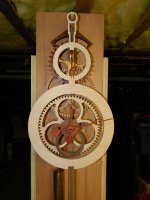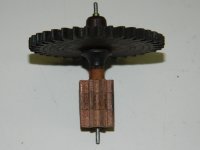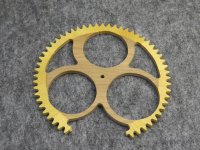This topic is closely monitored by several experts in psychology.at the oddity club, one can expect sporadic sputter
I try to stay away from luminescent exit signs, smoke detectors, and jets, thank you. Dental x rays, the kitchen countertop granite, and visiting my friends in vermont is enough exposure for me.
jn
And yah, the three extra ones stopped reappearing...
And just how do you think hexadecimal was really invented?
The continued time-delay of Mr Curl's posts, I experience as more demeaning.
I certainly find the delay a pita...it does tend to toss posts in between others where none existed.
I seem to recall it is self inflicted, a result of not pushing in the clutch prior to turning over the engine....so to speak.
That's ok..I am patient when the rewards justify it.
jn
Attachments
Last edited:
Huh? 47000 posts and still going strong. Lots of male bovine waste product, and a few gems. So why are you adding to the former?
haha, are you serious? I mean I know you leap to Johns defense in his absence sometimes, but defending his right to periodically and seemingly deliberately expose himself to ridicule? thats an interesting angle...
he certainly does have that right, its the worrying frequency of it and surprise (sometimes accompanied by vitriol) when it turns out badly.... again... that worries me
the point being that there are many areas where his posts garner substantial and almost universal admiration/respect, yet these are mostly neglected in favor of the former.
Last edited:
This topic is closely monitored by several experts in psychology.
I'm working towards a Ph. D in Group Dynamics
jan
I would like to point out that I stand 'in the middle' of a long exchange of opinions about audio quality and design. Many of the people that I know and work with are more educated than me, and are much further on the 'magic scale' than I would ever be. Sometimes, I just have to keep quiet, and not react negatively, at some new concept regarding audio improvements, until I have actually listened, and or my associates have invested time and money finding the source of this audio 'magic'. Because of past problems with 'exotic' approaches to audio reproduction, I generally refrain from putting them here, but if I must, to achieve balance in the conversation, I will, IF ALLOWED.
haha, are you serious? I mean I know you leap to Johns defense in his absence sometimes, but defending his right to periodically and seemingly deliberately expose himself to ridicule? thats an interesting angle...
he certainly does have that right, its the worrying frequency of it and surprise (sometimes accompanied by vitriol) when it turns out badly.... again... that worries me
the point being that there are many areas where his posts garner substantial and almost universal admiration/respect, yet these are mostly neglected in favor of the former.
I tell J.C. he is wrong every so often and he does enjoy a fight. But do you actually have a point or just feel the need to fertilize the thread?
I'm working towards a Ph. D in Group Dynamics
jan
More like an Asperger's clinic to me.
The hour ring is about 11 inches OD. The brass weight is 1.5 inch diameter, I filled it with molten lead.what sort of scale are we looking at here jneutron? its impressive regardless. worth the pulled tendon? anything snap? my friend recently snapped a tendon playing/practicing bass guitar and wont recover for possibly years; I trust your wasnt so serious
I didn't pull anything, but my hand was numb for about 2 weeks. Figured it was just sore from use, but two weeks was too long to be that. I had some micarda lift off the deck of the scroll saw a year ago, almost lost a nail..so scrolled in fear..
This is one of the repairs from a circa 1800 +/- antique clock. The pinion is 700 mils tall, 550 mils wide, 8 tooth. The blank was made from three pieces of 1/4 thick mahogany laminated with grain 90 degrees rotated. That way, the teeth were stronger.
Stained it later to match. I've already ordered some water based dyes, the pigment stains don't match easily with the hardwoods.
jn
ps..bass guitar? Man, pretty much my favorite...that is not nice.
Attachments
Last edited:
This topic is closely monitored by several experts in psychology.
Who are now going for therapy themselves..as a result.
I'm working towards a Ph. D in Group Dynamics
jan
Mine is in Goop Dynamics.
Um, simon..qusp.. a truce would be nice..please.
jn
Stained it later to match. I've already ordered some water based dyes, the pigment stains don't match easily with the hardwoods.
jn
If you're doing any museum quality restoration these folks have many hard to find things.
Dyes - Kremer Pigments Inc.
numb for about 2 weeks.
Sensitive to temperature changes (now) ?
John
Machine design, by Vladimir L. Maleev and James ... . - Full View | HathiTrust Mobile Digital Library
Has in the basics, when you have a part that wears make it harder or in two parts so it is easy to replace the wearing surfaces!
Pretty piece, but if it wore out after 150 years, did you need to improve it?
(Actually a real issue is the wood quality went down with over harvesting the trees, but as wood use has decreased some of the quality wood is back. A good example is West Virginia spruce, highly prized for guitars but almost all was used up to meet the war need for parts for biplanes! It is now back, although I did see one specialty store selling select matched pieces to make 1 back for $150.00!)
Machine design, by Vladimir L. Maleev and James ... . - Full View | HathiTrust Mobile Digital Library
Has in the basics, when you have a part that wears make it harder or in two parts so it is easy to replace the wearing surfaces!
Pretty piece, but if it wore out after 150 years, did you need to improve it?
(Actually a real issue is the wood quality went down with over harvesting the trees, but as wood use has decreased some of the quality wood is back. A good example is West Virginia spruce, highly prized for guitars but almost all was used up to meet the war need for parts for biplanes! It is now back, although I did see one specialty store selling select matched pieces to make 1 back for $150.00!)
I tell J.C. he is wrong every so often and he does enjoy a fight. But do you actually have a point or just feel the need to fertilize the thread?
I made the point, the point was that aligning the bybee to carrying out work relating to and at the same facility as synchrotron beamlines, is patently ridiculous and IMO pretty obnoxious. Synchrotron light is unraveling the world as we knew it, revolutionizing medical/drug research (thus may actually save my life one day), materials analysis and pretty much exposing life the universe and everything. It has been replicated on smallish to massive scale and studied/used by top scientists worldwide, the other...what does it actually do again?
throwing up such comparisons is literally asking to be mugged and it seems to be done willfully
now unless you are going to misunderstand that too somehow, can we drop it?
Last edited:
If you're doing any museum quality restoration these folks have many hard to find things.
Dyes - Kremer Pigments Inc.
Thanks, I will look into that. The day crew at the clock museum does the wood restoration for the cases. I do the guts in the evening, be it wood or brass.
Well, not my hands. Toes, yes..I hate cold...Sensitive to temperature changes (now) ?
John
Machine design, by Vladimir L. Maleev and James ... . - Full View | HathiTrust Mobile Digital Library
Has in the basics, when you have a part that wears make it harder or in two parts so it is easy to replace the wearing surfaces!
Pretty piece, but if it wore out after 150 years, did you need to improve it?
It didn't wear out. Apparently there was a winding "incident". Five gears lost teeth. Some only 1, that pinion 3, one lost 18 of it's 36. I thought that maybe the clock fell off the back of a truck at 60 miles per hour, and the tractor trailer tailgating it mowed it down.
jn
It didn't wear out. Apparently there was a winding "incident". Five gears lost teeth. Some only 1, that pinion 3, one lost 18 of it's 36. I thought that maybe the clock fell off the back of a truck at 60 miles per hour, and the tractor trailer tailgating it mowed it down.
jn
We could talk about wood selection. For hand working American Walnut is great but not traditional. For that try Indian Rosewood, strong, smooth grain and finishes nicely. Enough color variation among the wood that you can match most of the older favorite woods.
Real Mahogany is hard to find and tends to chip a bit when carved.
Many years back my father repaired a dining room set single chair. It had a curved engraved back. I gave him a piece of mahogany, he cut and carved it, then we steam bent it to fit. Putting the finished piece back in the set we realized the originals actually used a mahogany finished softer wood. It would have been much easier to make. The set is still around and no one else has ever noticed one chair back is real mahogany and the rest fake!
The message that I am getting is that I expose myself to criticism by bringing up taboo topics or individuals, even if I have experience and acquaintance with them, as if this was some sort of 'politically correct' thread.
If I am allowed, I would like to bring up another 'story' that happened back in 1978, or 35 years ago, at an IEEE conference on Audio and Electroacoustics.
I was talking with Walt Jung, who was also giving a paper there, when we happened on the professor who had rejected Walt's original SID paper for submission into the JAES.
I was standing next to Walt when he asked the professor (AES referee) what was wrong with the paper that was coauthored by two other engineers as well as Walt. The professor said that he 'didn't like the math' pointing to a section where one of the other engineers had added something on the Volterra Series, and this professor didn't like it, BUT he could not tell us why.
Now, it just happens that I took a class at UCB with the same engineer who put the Volterra Series section in the paper and I learned it from the same professor at the same time as he did. Now, maybe, of course, the other engineer 'might' have gotten the math wrong, how would I know for sure? Well, just this week I got a paper on the Volterra Series coauthored by both RG Meyer and this other engineer, perhaps as his masters thesis. I now know that this other engineer knew what he was doing, far more than I could ever do, because he had worked with Dr. Meyer to a much greater extent with the Volterra Series than we ever learned in class. Therefore the 'professor' who rejected the paper, was full of it, and if he had any real evidence against the 'math' he should have PROVEN IT in writing, and not just by fiat, before rejecting the SID paper.
What happened then? Both of the other engineers contributing to the SID paper, DROPPED OUT, scared of being tarnished by being associated with SID.
Walt had to publish it in 'The Audio Amateur' or TAA alone, and the other two ran like scared chickens! I guess that is what I am supposed to do with 'advanced or controversial' material. Well, I won't be deterred from giving information as I see it.
If I am allowed, I would like to bring up another 'story' that happened back in 1978, or 35 years ago, at an IEEE conference on Audio and Electroacoustics.
I was talking with Walt Jung, who was also giving a paper there, when we happened on the professor who had rejected Walt's original SID paper for submission into the JAES.
I was standing next to Walt when he asked the professor (AES referee) what was wrong with the paper that was coauthored by two other engineers as well as Walt. The professor said that he 'didn't like the math' pointing to a section where one of the other engineers had added something on the Volterra Series, and this professor didn't like it, BUT he could not tell us why.
Now, it just happens that I took a class at UCB with the same engineer who put the Volterra Series section in the paper and I learned it from the same professor at the same time as he did. Now, maybe, of course, the other engineer 'might' have gotten the math wrong, how would I know for sure? Well, just this week I got a paper on the Volterra Series coauthored by both RG Meyer and this other engineer, perhaps as his masters thesis. I now know that this other engineer knew what he was doing, far more than I could ever do, because he had worked with Dr. Meyer to a much greater extent with the Volterra Series than we ever learned in class. Therefore the 'professor' who rejected the paper, was full of it, and if he had any real evidence against the 'math' he should have PROVEN IT in writing, and not just by fiat, before rejecting the SID paper.
What happened then? Both of the other engineers contributing to the SID paper, DROPPED OUT, scared of being tarnished by being associated with SID.
Walt had to publish it in 'The Audio Amateur' or TAA alone, and the other two ran like scared chickens! I guess that is what I am supposed to do with 'advanced or controversial' material. Well, I won't be deterred from giving information as I see it.
The hour ring is about 11 inches OD. The brass weight is 1.5 inch diameter, I filled it with molten lead.
I didn't pull anything, but my hand was numb for about 2 weeks....snip
This is one of the repairs from a circa 1800 +/- antique clock. The pinion is 700 mils tall, 550 mils wide, 8 tooth. The blank was made from three pieces of 1/4 thick mahogany laminated with grain 90 degrees rotated. That way, the teeth were stronger
ps..bass guitar? Man, pretty much my favorite...that is not nice.
yeah i'm in awe of this sort of patience and confidence; especially with materials that once a mistake is made, can mean starting over. My hands would be shaking. small scale soldering is one thing, but mostly can be just removed and done again if need be. The closest I come to that type of dexterity is pen and ink hatch work/etching.
Yes my friend, I went to visit him the other day to check out and help set up his new home studio. he collects and restores Bass guitars and old analogue synths as well, but most notably plays excellent slap bass and funk. As you probably know slap bass is very hard work and his tendon in his wrist/forearm just let go during an epic practice session for a track hes working on. Hes all strapped up and cant hold anything, probably not for a while either.
We could talk about wood selection. For hand working American Walnut is great but not traditional. For that try Indian Rosewood, strong, smooth grain and finishes nicely. Enough color variation among the wood that you can match most of the older favorite woods.
I'm really having fun learning about how the different woods work. Some of the gears are ash, mahogany seems good with it. Walnut is closer in color, but it seems to have some issues in workability. Small geometry cross grain has been problematic.
Never mistake confidence with sheer brute force stupidity...yeah i'm in awe of this sort of patience and confidence; especially with materials that once a mistake is made, can mean starting over.
It's therapy for me.
And still, sometimes I'm the windshield, and sometimes I'm the bug..
Ya learn from your mistakes...i must be a genius by now...
jn
Attachments
- Status
- Not open for further replies.
- Home
- Member Areas
- The Lounge
- John Curl's Blowtorch preamplifier part II


